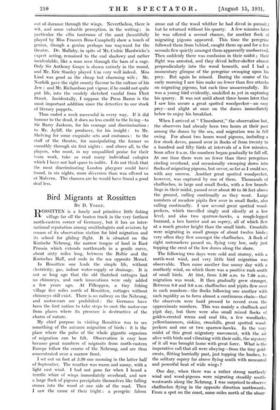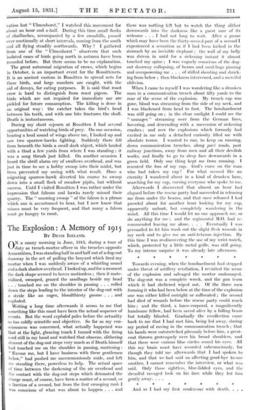Bird Migrants at Rossitten BY D. YORKE. R OSSITTEN is a
lonely and primitive little fishing village far off the beaten track in the very farthest north-eastern corner of Germany, but it has an inter- national reputation among ornithologists and aviators by reason of its observation station for bird migration and its school for gliding flight. It is situated on the Kurische Nehrung, the narrow tongue of land in East Prussia which extends northwards in a gentle curve, about sixty miles long, between the Baltic and the Kurisches Haff, and ends in the sea opposite Memel.
In Rossitten one leads the simple life, without electricity, gas, indoor water-supply or drainage. It is not so long ago that the old thatched cottages had no chimneys, and such innovations were only added a few years ago. At Pilkoppen, a tiny fishing village five miles north of Rossitten, cottages without. chimneys still exist. There is no railway on the Nehrung, and motor-cars are prohibited : the Germans have been the first nation to take steps to oust the motor-car from places where its presence is destructive of the charm of nature.
My chief purpose in visiting Rossitten was to see something of the autumn migration of birds : it is the place where the pulse of the whole gigantic organism. of migration can be felt. Observation is easy here because great numbers . of migrants from north-eastern . Europe follow the course of the Nehrung, and are thus. concentrated over a narrow front.
I set out on foot at 5.30 one morning in the latter halt of September. The weather was warm and sunny, with a light cast wind. I had not gone far when I heard a terrific whirr of wings immediately overhead, and saw a large flock of pigeons precipitate themselves like falling stones into the wood at one side of the road. Then I saw the cause of their fright : a peregrine falcon arose out of the wood whither he had dived in pursuit ; but he returned without his quarry. A few minutes later he was offered a second chance, for another flock of migrating pigeons appeared. This time the peregrine followed them from behind, caught them up and for a few seconds flew quietly amongst them apparently unobserved. Then suddenly there was confusion in their midst ;. their flight was arrested, and they dived helter-skelter almost perpendicularly into the wood beneath, and I had a momentary glimpse of the peregrine swooping upon his prey. But again he missed. During the course of the early morning I saw him make no fewer than five attacks on migrating pigeons, but each time unsuccessfully. He was a young bird evidently, unskilled as yet in capturing his quarry. It was not until about three hours later that I saw him secure a great spotted woodpecker—an easy prey—and alight at once on the dunes immediately below to enjoy his breakfast.
When I arrived at " Ulmenhorst," the observation hut, the observers had already been two hours at their post among the dunes by the sea, and migration was in full swing. For about two hours wood pigeons, including a few stock doves, passed over in flocks of from twenty to a hundred and fifty birds at intervals of a few minutes. Soon after 9 a.m. the numbers began gradually to fall off. At one time there were no fewer than three peregrines circling overhead, and occasionally swooping down into flocks of migrating pigeons, but never, so far as I could see, with any success. Another great spotted woodpecker, however, was captured by one of them. Thousands of chaffinches, in large and small flocks, with a few bramb- lings in their midst, passed over about 30 to 50 feet above the ground, calling continually as they went. Large numbers of meadow pipits flew over in small flocks, also calling continually. I saw several great spotted wood- peckers, which travelled singly and silently at a low level, and also two sparrow-hawks, a rough-legged buzzard, a hen harrier and an osprey, all of which flew at a much greater height than the small birds. Crossbills were migrating in small groups of about twelve birds ; very often they flew amongst the chaffinches. A flock of eight nutcrackers passed us, flying very low, only just topping the crest of the low dunes along the shore.
The following two days were cold and stormy, with a north-west wind, and very little bird migration was observable. Then came another fine sunny day with a southerly wind, on which there was a positive rush south of small birds. At first, from 5.30 a.m. to 7.30 a.m., migration was weak. It then gradually grew stronger. Between 8.0 and 9.0 a.m. chaffinches and pipits flew over in such numbers—the flocks following one another with such rapidity as to form almost a continuous chain—that the observers were hard pressed to record even the approximate numbers. This was mainly a chaffinch and pipit day, but there were also small mixed flocks of golden-crested wrens and coal tits, a few woodlarks, yellowhammers, siskins, crossbills, great spotted wood- peckers and one or two sparrow-hawks. In the very midst of this great migratory movement, with the air alive with birds and vibrating with their calls, the mystery of it all was brought home with great force. What is the imperative call that all were obeying—from the tiny gold- crests, flitting hurriedly past, just topping the bushes, to the solitary osprey .far above flying south with measured and powerful beat of wide wings ?
One day, when there was a rather strong northerly wind and wood-pigeons were migrating steadily south- westwards along the Nehrung, I was surprised to observe chaffinches flying in the opposite direction northwards. From a spot on the coast, some miles north of the obser- vation hut " Ulmenhorst," I watched this movement for about an hour and a-half. During this time small flocks of chaffinches, accompanied by a few crossbills, passed over continually at short intervals, coming from the south and all flying steadily northwards. Why ? I gathered from one of the " Uhnenhorst " observers that such isolated cases of birds going north in autumn have been recorded before. But there seems to be no explanation.
The great autumnal migration of crows, which begins in October, is an important event for the Rossitteners. It is an ancient custom in Rossitten to spread nets for these birds, and large numbers are caught, with the aid of decoys, for eating purposes. It is said that roast crow is hard to distinguish from roast pigeon. The birds which are not required for immediate use are pickled for future consumption. The killing is done in an original way : the catcher takes the bird's head between his teeth, and with one bite fractures the skull. Death is instantaneous.
During my short sojourn at Rossitten I had several opportunities of watching birds of prey. On one occasion, hearing a loud sound of wings above me, I looked up and saw two sparrow-hawks fighting. Suddenly there fell from beneath the birds a small dark object, which landed with a thud a few yards from where I was standing ; it was a song thrush just killed. On another occasion I heard the shrill alarm cry of swallows overhead, and was just in time to see a hobby swoop into their midst, but trees prevented my seeing with what result. Once a migrating sparrow-hawk diverted his course to swoop down into a small flock of meadow pipits, but without success. Until I visited Rossitten I was rather under the impression that falcons and hawks rarely missed their quarry. The "unerring swoop" of the falcon is a phrase which one is accustomed to hear, but I now know that misses must be very frequent, and that many a falcon must go hungry to roost.































 Previous page
Previous page